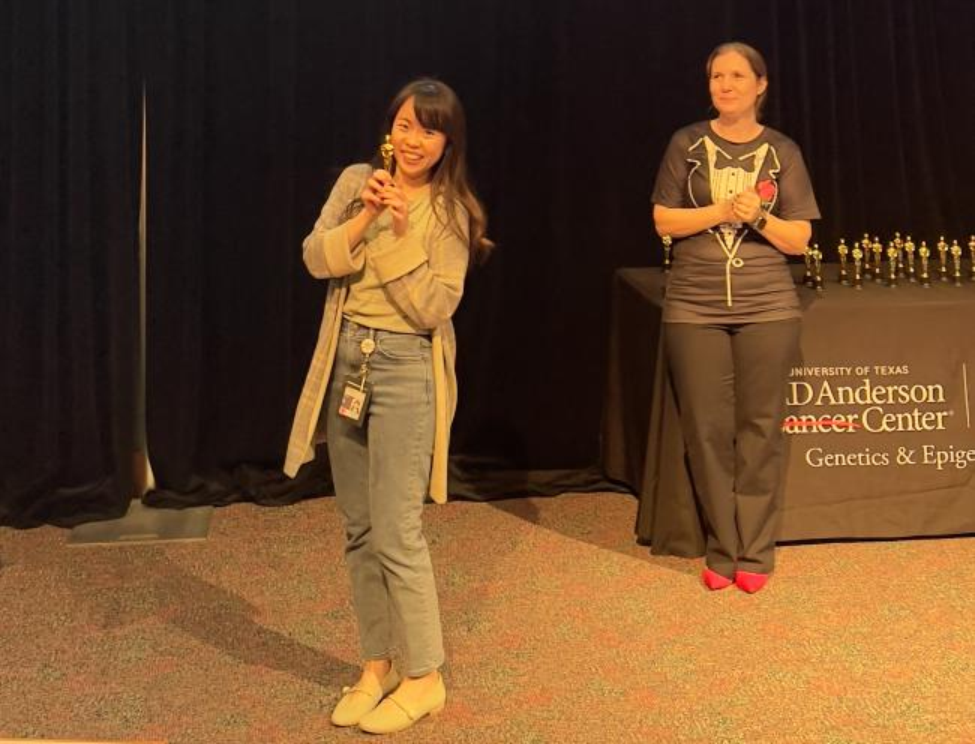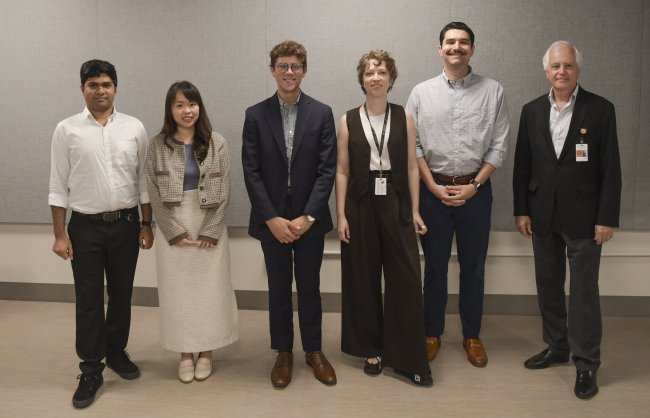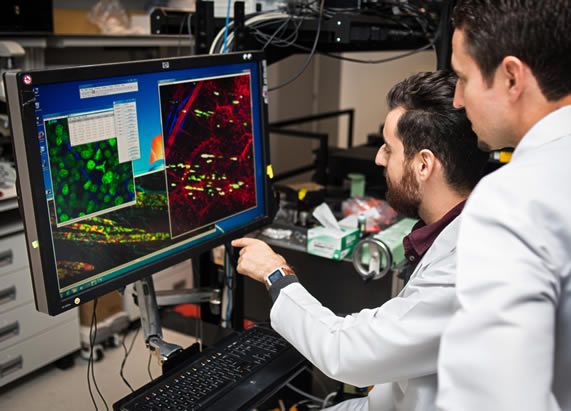July’s Paper of the Month explores how RNA modifications by TRMT1L ensure cell health during oxidative stress
July 29, 2025 By: Jana Gomez/Graduate Student/Microbiology and Infectious Diseases Program/MD Anderson UTHealth Houston Graduate School



Paper of the Month: TRMT1L-catalyzed m22G27 on tyrosine tRNA is required for efficient mRNA translation and cell survival under oxidative stress
Precise gene regulation is one of the key methods that our cells use to maintain their health. Often, various environmental stimuli that may be harmful to cells, such as high temperatures and low oxygen, act as signals to activate genes that can help to mitigate the effects of these stimuli. But how do these signals control gene expression? Typically, modifications of gene expression are done via disruption of the central dogma.
The central dogma of biology states that to make a protein, first DNA is replicated by an enzyme called a polymerase. Once this copy of DNA is made, another polymerase uses this code to create a corresponding messenger RNA (mRNA). mRNA can then be taken to the ribosome, where transfer RNA (tRNAs) will match the code of the mRNA to their corresponding amino acid, which are linked together to make a protein.
One of the most common regulatory mechanisms in our cells is modification of various RNA molecules. tRNAs are actually the most modified RNA, with an average of 10-13 modifications per molecule! It is essential that these modifications occur correctly, because without properly functioning tRNAs, mRNAs cannot be made into their desired protein. Unproper modifications of tRNAs have been linked to several human diseases, including various cancers.
Understanding how these modifications occur is the main focus of Genetics and Epigenetics student Sseu-Pei Hwang’s work. “Many of the enzymes that deposit these RNA modifications are found to be deregulated in tumors, yet how their altered activity reshapes the proteome remains poorly understood,” she says. “That gap in knowledge is exactly what our work aims to address.”
Stumbling on a tRNA modification gold mine
Sometimes experiments don’t have very exciting results. Other times, one experiment will lead to an interesting discovery that inspires future projects. This is the case with Hwang’s work. Originally, her lab was performing experiments to identify components of the ribosome biogenesis complex Rix1. Through their analysis, they found that tRNA methyltransferase 1 like (TRMT1L) protein interacts with this complex. Interestingly, TRMT1L has been previously shown to be overexpressed in invasive breast and colon cancers, emphasizing its importance.
Since this complex was thought to be important for translation in mammalian cells, Hwang aimed to further determine what TRMT1L’s role was. They first wanted to answer the question – does TRMT1L regulate ribosome synthesis? Although the group observed that TRMT1L could be isolated from cells with ribosome subunits, lower TRMT1L levels did not result in the processing of ribosomal RNA (rRNA).
The next question Hwang and the other authors of the article (published in Cell Reports) had was what RNAs are modified by TRMT1L? To answer this question, the authors used genome wide crosslinking and immunoprecipitation (eCLIP) sequencing analysis, which accurately defines the RNA substrate of proteins. As expected, most of the RNAs that TRMT1L were binding to included both rRNAs and tRNAs. Specifically, tRNAs that help to encode the amino acids for cysteine (tRNA-Cys) and tyrosine (tRNA-Tyr) were found to be associated with TRMT1L.
Now that the authors knew that TRMT1L could bind to specific RNAs, they wanted to determine what modifications, if any, TRMT1L made on the RNAs. Interestingly, TRMT1L did not modify any rRNAs, despite its association with the Rix1 complex.
Next, Hwang looked at the modifications on various tRNAs by using positive hybridization in absence of modification tracking (PHA), a common method for identifying RNA modifications. Depleting TRMT1L showed a loss of modifications found on the D-loop of tRNA-Cys and tRNA-Tyr. However, restoring a non-active version of TRMT1L in the cells restored this modification, suggesting that TRMT1L may be assisting in this modification, but is not performing this modification itself.
Uncovering answers with new technology
Since her PHA analysis was not providing enough evidence to address her question, Hwang shifted gears to utilize a new method in a unique way. To focus in on modifications that TRMT1L was directly responsible for performing, Hwang used a sequencing method called Nano-tRNA-seq, which is a much more specific method compared to PHA. “One of my favorite aspects [of this paper] is our nanopore-based tRNA sequencing data, which represents the first published study to apply direct RNA nanopore sequencing for analyzing tRNA modifications in humans” she said.
Utilizing Nano-tRNA-seq in this context for the first time wasn’t easy—Hwang had to expand her skills as a scientist in new directions. “As someone trained primarily as a bench scientist, developing this nanopore analysis pipeline marked a personal milestone in my professional development,” she said. “This experience not only helped me build up my technical skills but also showed me that even as a bench scientist, I can develop a useful bioinformatic pipeline that others can use, not just follow what’s already out there.
Her efforts ended up being worth it. The Nano-tRNA-seq analysis identified two major modifications that TRMT1L was responsible for – it directly catalyzing N2,N2-dimetylguanosine (m22G) modification on tRNA-Tyr and also involved in regulating other modifications such as 3-amino-3-carboxypropyl (acp3U) on the D-loop of tRNA-Tyr and tRNA-Cys.
m22G modifications are commonly thought to be involved in stabilizing the tRNA by creating stronger bonds on the tRNA core. Disruption in these modifications could result in tRNAs breaking apart, which can result in inefficient translation of proteins. acp3U modifications are also thought to be involved in tRNA stability. Interestingly, acp3U groups were found in high levels in breast cancer cells, suggesting that this modification may play a role in cancer development.
Since TRMT1L regulates these modifications, Hwang then wanted to determine if TRMT1L influenced mRNA translation efficiency and overall cell survival. When they deleted TRMT1L from cells, they observed that mRNA was translated much less efficient compared to wild type cells. Furthermore, the cells were also hypersensitive to oxidative stress, such as in the presence of hydrogen peroxide. These data confirmed the essential role of TRMT1L in maintaining balance in the cell and implicated the protein in cancer development.
Inspiring from field to field
Understanding the mechanisms of cancer development is essential for treatment and prevention. “I’m particularly excited about how this manuscript connects RNA modification and translational reprogramming, two fascinating yet intricate aspects of gene regulation in cancer,” Hwang said. “By uncovering the underlying molecular mechanism, this work opens the door to identifying druggable targets for cancer therapy that interfere with this stress-adaptive translation program.”
But not only cancer biologists can benefit from the knowledge that Hwang has published. “Initially, I expected this research would mainly resonate with scientists focused on RNA modifications and translational control,” she said. “I was surprised to receive questions and feedback from researchers in areas I hadn’t anticipated.”
Discoveries like Hwang’s emphasize the importance of sharing our science with everyone. “[The reception of this article] made me realize that even small, technical details in a manuscript might turn out to be critical information for someone else, and how my research makes a good impact on the scientific community.”
Among her academic awards, Hwang was recently one of the recipients of the Jess Hay Chancellor's Fellowship 2026. Her mentor is Catherine Denicourt, PhD.
Paper of the Month is a collaborative effort led by Microbiology & Infectious Diseases PhD candidate Jana Gomez, overseen by Associate Dean for Academic Affairs Francesca Cole, PhD, who collaborate with students to summarize fellow student-authored scientific articles about their biomedical science research and the innovative methods and discoveries they are uncovering.







